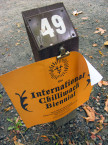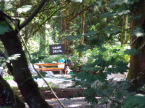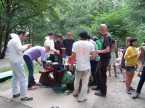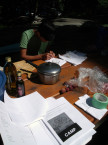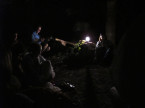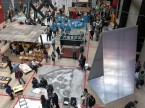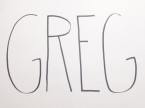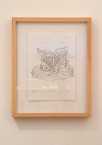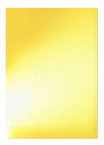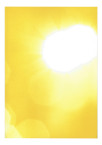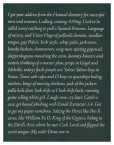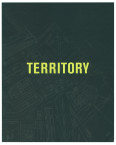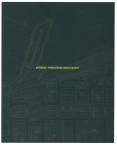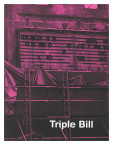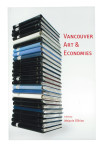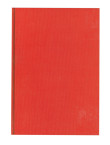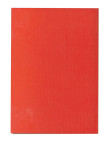Exhibitions
-
JULIA FEYRER
November 13–January 8, 2011Referencing experimental film, performance documentation, and filmmaking-as-process, Julia Feyrer’s 16mm film, The Poodle Dog Ornamental Bar, was shot on a “film set” the artist constructed in a Vancouver backyard. Modeled on an 1890’s Gastown bar of the same name, Feyrer activated her temporary illegal bar (serving home brewed Frankfurt style apple wine) with performances, readings, and events. These events and their audiences provide the cast and soundtrack for the non-narrative film that is itself an accumulation of improvisations, collaborations, and cinematic visual compositions, placing the historical past as a backdrop to its reinterpreted present.
Postscript 40: Michael Turner on The Poodle Dog Ornamental Bar (PDF)
-
…a legend, it, it sounds like a legend…
HANNAH RICKARDS
September 11–October 30, 2010THE SOUND I THINK IT MAKES IS, IS THAT WHISPERING SOUND, TO ME IT SOUNDS, IT ALMOST SOUNDS, UM, UH, WHAT’S THE WORD I’M THINKING? UM, LIKE HISTORIC, NOT HISTORIC, BUT, UM, OH: A LEGEND, IT, IT SOUNDS LIKE A LEGEND, YOU KNOW, WHEN YOU THINK OF A LEGEND OR SOMETHING WAY BACK IN THE PAST YOU GET THAT, THAT, IT SOUNDS LIKE THAT TO ME, LIKE THIS LEGEND OR SOMEBODY’S, THIS WHISPERING SOUND: IT’S A LEGEND.
Hannah Rickards’ practice centres on the translation of natural phenomena into sound, text, and installation. …a legend, it, it sounds like a legend… is a three monitor installation that contends with the description of the sound of the northern lights from observers in northern British Columbia and central Alaska. Rickards’ work shifts between modes of perception and representation including the linguistic, the visual, the natural, and the artificial.
Postscript 39: Robert Arndt on …a legend, it, it sounds like a legend… (PDF)
-
International Chilliwack Biennial
MARKUS MIESSEN, RON TRAN, OSCAR TUAZON
July 28–July 29, 2010Artspeak, Or Gallery, and Bodgers’ and Kludgers’ Co-operative present:
International Chilliwack Biennial
The International Chilliwack Biennial takes place July 28 and 29 at the Delta Grove campsite of Cultus Lake Provincial Park near Chilliwack, BC. The event is an open question on large-scale exhibitions and takes a consciously precarious approach. This is the DIY, near-zero budget biennial—the bodged biennial. Shoe-horned amidst other campers in a state-run camping area, the International Chilliwack Biennial quietly goes about its business. This is the biennial that doesn’t sit up quite right, that wobbles, that is, perhaps, rained-out. Offsite, contingent, last minute favours: borrow your dad’s sleeping bag and your neighbour’s tent. The International Chilliwack Biennial hopes to make you feel different about camping.
Understood as a prototype, the event will consider the biennial as studio or performance. Works will be created, rearranged, consumed, found and dusted off. Tents, trailers, and other portable or temporary structures will form pavilions for international projects. At our symposia smoke may get in your eyes. We don’t have a PA system, but we may be able to offer you a marshmallow. Enjoy.
Park: Cultus Lake Provincial Park Campground: Delta Grove Directions: Cultus Lake Provincial Park is located 11km southwest of Chilliwack, BC. Access to the park is off Highway 1 at the Yarrow or Sardis exits. It is 16 km to the park entrance from Yarrow and 10 km from Sardis via the Columbia Valley Highway, which bisects the southeast section of the park.
See www.chilliwackbiennial.org for updated information.
This is the final program in Artspeak’s two-year OFFSITE series.
ARTSPEAK PRESENTS
RON TRAN
Ron Tran’s practice typically examines the influence of chance and coincidence in daily life. Contending with the campfire ban and as of yet unforeseen culinary hurtles, Ron is designing a dinner menu for the Wednesday evening of the International Chilliwack Biennial.
MARKUS MIESSEN
The work of architect and writer Markus Miessen considers spatial strategies and cultural analysis, accommodating change through research, criticism, writing, teaching, and design. The editor of a trilogy of publications on participation, his most recent book, The Nightmare of Participation (Crossbench Praxis as a Mode of Criticality), is due out later this year. For the International Chilliwack Biennial Miessen not only provided six of his texts from this book for distribution and discussion in relation to the collective and offsite activities of the ICB, but also designed the ICB’s camp headquarters.
OSCAR TUAZON
Oscar Tuazon’s practice engages with do-it-yourself architectural concepts. Responding to the circumstances of camping at Cultus Lake for the International Chilliwack Biennial, Tuazon will read a campfire tale.
-
No Soul For Sale (Turbine Hall, Tate Modern)
LUCY PULLEN
May 14–May 16, 2010In celebration of the Tate Modern’s 10th anniversary, the gallery is hosting No Soul For Sale—A Festival of Independents. The festival brings together over 70 of the world’s most exciting independent art spaces, non-profit organizations, and artists’ collectives, from Vancouver to Shanghai to Rio de Janeiro, to take over the iconic Turbine Hall with an eclectic mix of arts events, performances, music, and film. Neither a fair nor an exhibition, No Soul For Sale is a convention of individuals and groups who present work beyond the limits of the market and other logistical constraints—it is a celebration of the independent forces that animate contemporary art. The festival is an exercise in coexistence: organizations exhibit alongside one another without partitions or walls.
Artspeak is presenting a project by artist Lucy Pullen at No Soul for Sale. Entitled Blind Spot, Pullen’s towering, freestanding tent-like structure is skinned in reflective fabric. An extension of her recent Artspeak project, I Would Prefer Not To (which pulled reflective blinds on the gallery during the Vancouver 2010 Winter Olympics), Pullen uses the same material to present the notion of a blind spot within the spectacle, positing Artspeak in a position of complicated stake-claiming, complicity, and refusal. The tent’s reflective fabric interrupts the process of mechanical reproduction. When photographed with a flash, a white hole appears in the image. When the viewer occupies a mid-point between the work of art and a light source, the work “pops” or jumps in hue from an indistinct grey to a blinding white light. For over ten years Pullen has used this material to make works of art (sculptures and photographs) that challenge media. Both exclusionary and interactive, Pullen’s tent questions ideas of participation and indifference, calling into question participation in the social, ethical, and economic conundrums surrounding events like No Soul for Sale as much as she does for large corporate parties such as the Olympics. Viewers are invited to photograph Blind Spot with flash and lens in close proximity. Pullen will present the artistic use of 3M reflective fabric on Sunday May 16th at 12:30 in the Tate Modern auditorium.
No Soul For Sale—A Festival of Independents is curated by Cecilia Alemani, Maurizio Cattelan and Massimiliano Gioni, and produced by Tate Modern. The first edition of No Soul For Sale took place in June 2009 at X initiative in the former Dia Center for the Arts in New York.
Independent arts organizations taking part in No Soul For Sale include:
2nd Cannons Publications (Los Angeles), 98weeks research project (Beirut), Alternative Space LOOP (Seoul), Arrow Factory (Beijing), ArtHub Asia (Shanghai/Bangkok/Beijing), Artis – Contemporary Israeli Art Fund (New York/Tel Aviv), Artists Space (New York), Artspeak (Vancouver), Auto Italia South East (London), Ballroom (Marfa), Barbur (Jerusalem), Black Dogs (Leeds), Capacete Entertainment (Rio de Janeiro), casa tres patios (Medellín), Cinématèque de Tanger (Tanger), cneai= (Paris-Chatou), Collective Parasol (Kyoto), Dispatch (New York), e-flux (Berlin), Elodie Royer and Yoann Gourmel – 220 jours (Paris), Embassy (Edinburgh), Filipa Oliveira + Miguel Amado (Lisbon), FLUXspace (Philadelphia), FormContent (London), Galerie im Regierungsviertel / Forgotten Bar Project (Berlin), Green Papaya Art Projects (Manila), Hell Gallery (Melbourne), Hermes und der Pfau (Stuttgart), i-cabin (London), Intoart (London), K48 Kontinuum (New York), Kling & Bang (Reykjavík), L’appartement 22 (Rabat), Latitudes (Barcelona), Le commissariat (Paris), Le Dictateur (Milan), Light Industry (New York), Lucie Fontaine (Milan), lugar a dudas (Cali), Mousse (Milan), Next Visit (Berlin), New Jerseyy (Basel), Not An Alternative (New York), no.w.here (London), Or Gallery (Vancouver), Oregon Painting Society (Portland), Para/Site Art Space (Hong Kong), Peep-Hole (Milan), PiST/// (Istanbul), Post-Museum (Singapore), PSL [Project Space Leeds] (Leeds), Rhizome (New York), Sala-Manca & Mamuta (Jerusalem), Sàn Art (Ho Chi Minh City), Scrawl Collective (London), studio1.1 (London), Swiss Institute / Contemporary Art (New York), The Mountain School of Arts (Los Angeles), The Museum of Everything (London), The Royal Standard (Liverpool), The Suburban (Chicago), The Western Front Society (Vancouver), Thisisnotashop (Dublin), Torpedo – supported by the Office for Contemporary Art Norway (OCA), Tranzit.cz (Prague), Viafarini DOCVA (Milan), Vox Populi (Philadelphia), Western Bridge (Seattle), White Columns (New York) and Y3K (Melbourne).
-
ALEX MORRISON
March 27–May 1, 2010Alex Morrison’s practice examines urban built environments and their subcultures, from hippies and activists to re-enactors and skateboarders. Politically inflected, Morrison’s work troubles notions of authenticity, particularly when the “authentic” is absorbed into the mainstream. His project for Artspeak, Making Beer More Expensive, comments on the renewal of Carrall Street and Vancouver’s “heritage district” of Gastown within a cyclical history.
Morrison’s installation takes the complex aesthetics of Gastown’s revival in the 1970s as a starting point. Appropriating signage standards, forms, and messages, contextualized by supplementary archival documents, the Artspeak installation uses the specific language of the era during which the neighbourhood transitioned from working to middle class through urban planning and community initiatives. Morrison’s work is invested in the aesthetics of civic infrastructure and the local counterculture as they are articulated under the guise of history.
An example of preservationist development, Gastown shifted to occupy a central position in Vancouver’s tourist economy. In 1971 it was declared an historic district by the provincial government. The city plans at the time were theme park-esque and included historic looking laid brick sidewalks, cobblestones in Trounce Alley, gas lamp style lighting, and strict heritage protection for buildings. At the same time as this re-imagination, it was a hub for artistic and leftist activities and commerce—from hippie protests and occupations to art galleries and speakeasies—that complicated the gentrification of the neighbourhood.
Making Beer More Expensive posits that the Gastown cycle of development has parallels to a kind of cosmetic Victorian parlour room civility associated with the aspidistra cult. As the title infers, the “civilized” qualities of new zoning and businesses moving into the Victorian buildings in Gastown inflated the prices of goods and services in the area, particularly in bars and pubs. With a nod to Artspeak’s location within this history, Morrison’s installation considers the authenticity of history and its markers, and the intersection between the commercial and the aesthetic, countercultural values and lifestyle culture.
This project will be followed by an OFFSITE project that Morrison is undertaking with Artspeak in future years. His carved wooden sign, Remove Not the Old Landmarks, is scheduled to be permanently installed on a new building designed by architect Gregory Henriquez.
-
CHRISTIAN BÖK
February 1–March 23, 2010Engaging the language and descriptive purpose of Artspeak’s exterior hanging sign, poet Christian Bök has created an anagram for the sign. Artspeak’s original sign announced the organization’s exhibitions, publications, and talks. The new sign announces philistines, bailout, toxic banks. Ratspeak was developed out of Bök’s past work with anagrams, specifically his collaborative project with Micah Lexier entitled Two Equal Texts that was installed in the windows of Printed Matter (New York), MKG 127 (Toronto), and turned into an edition with Fillip. Bök has written, “For me, every anagram underlines the degree to which language, in advance, has already anticipated, if not inventoried, the alphabetical permutations of our own thoughts–and even this sublime concept already exists somewhere else, written on another page and spoken by another voice. As Borges writes: “to speak is to fall into tautologies”and “the certainty that everything has been already written nullifies or makes phantoms of us all…”” Despite the numerous permutations possible for Artspeak’s sign, the specific political inflection of Bök’s work is timely given the provincial arts cuts in BC, the 2010 Olympics, the federal and global economic situation, and the recent changes in Artspeak’s immediate neighbourhood. If “artspeak” is a specialized language, “ratspeak” is also specialized, a calculated double speak of veiled meaning.
-
KIM KENNEDY AUSTIN
April 24–July 1, 2009Kim Kennedy Austin has designed a postage stamp for Artspeak. The project is the result of an invitation to the artist to intervene in some aspect of the gallery’s daily operations. The 54¢ Canadian domestic stamp will be used by Artspeak in the upcoming months to mail invitations, letters, and bills.
Canada Post uses stamp imagery to construct national identity, illustrating Canadian flora and fauna, celebrating holidays and events, recognizing Black History month and key figures in Canadian history. The authority of the Canadian stamp has recently given way to personalization. For a fee, individuals (and organizations) can customize a stamp, often for birth or wedding announcements. This personalization disrupts the original dominion of the stamp, revealing a bygone notion of nation that has been usurped by personal identity and commerce.
Austin’s project inserts Artspeak, and her work, into a national context. It not only considers national, institutional, artistic, and personal symbolism, but also conjures up the activities of collecting (stamps and art). The stamp’s talking heads connect it to recent projects by the artist that draw on book design from the last four decades while offering Artspeak a dubious purchase on a previously untapped branding opportunity.
-
AARON CARPENTER, JOEL HERMAN, ROULA PARTHENIOU
April 11–June 6, 2009Since September 2008, Artspeak’s ONSITE space has been dedicated to artist books, archives, libraries, and reading rooms. As an inversion of this, Artspeak is presenting Literally, an exhibition with an OFFSITE component that includes three artists working with the form of the book to make drawings, paintings, and video.
In their work, Aaron Carpenter, Joel Herman, and Roula Partheniou play with the representation and referentiality of literature and knowledge in humorous ways. Interested in both mimicry and the processes of research, the artists consider the formal and connotative aspects of the book and the printed word as readymades and as points for further fiction. The readymade titles used by the artists become fictions in their own right, as Carpenter’s Polyglot drawing series and video point to. Carpenter’s drawings are altered facsimiles of book covers in which James Joyce’s Finnegans Wake is mentioned. In Finnigan(sp) Must Die!!!, Joyce’s work appears as science fiction, rendered part of the fictional universe of space travel, the starship Enterprise, and Spock. Carpenter’s related video extends the parallels between Joyce’s text and science fiction in filmic proportions on the Robson and Granville video board. Herman’s meticulous drawings reproduce related book title pages at a one-to-one scale. The books are chosen for their titular language and often function in pairs such as the following: Meaning and Expression / Expression and Meaning or Language and Logic / Logic and Language. Herman’s formal interest in symmetry plays out in subtle variations in scale and meaning. Partheniou’s paintings of books operate as trompe l’oeil in the round, using the three-dimensionality of the readymade canvases to mimic the book form. The paintings (in stacks or groupings) construct their own narratives, while operating as exercises in language, scale, and ultimately pointing to the transformative aspects of re-making.
-
ALLISON HRABLUIK
March 17–April 26, 200928 thoughts while writing your name:
I have a maddeningly terrible crush on you. Hello. I think you are remarkable. This is urgent. Soon we will meet. I’m not stalking you. I don’t even know you but I feel so close to you. I’ve heard a lot about you. Yes, we all know you did that. I think you should apologize. You are a very good friend. You have always been a very good friend. I’d like to get to know you better. Only admiration. Are you lonely? I saw you at the grocery store the other day. You are very smart, and even funny. I’ve never really liked you. I am not yelling at you. Sorry. You are so attractive. I bet you have a firm handshake. This is how I reach out. I hope you don’t know it’s me right away. I know we will never meet. I love your name. I have something very important to tell you.
On March 17, 2009, 435 envelopes were deposited into a Canada Post mailbox in Vancouver. Each envelope contained a large piece of paper on which the addressee’s name was written in capital letters.
-
JUDGMENT AND CONTEMPORARY ART CRITICISM
February 14–March 28, 2009Opening reception Friday, February 20, 8pm
Organized by Artspeak and FillipAs a complement to the forum, Artspeak will house a reading room of texts, publications and journals related to issues of judgment in contemporary art criticism. The reading room will build on Artspeak’s ONSITE programming, allowing a space for study, conversation and information.
A workbook including detailed information about the forum and panelists, as well as a selection of reprinted texts related to issues of valuation and art criticism, will be available free of charge at the reading room and at various galleries throughout the Vancouver. The workbook will function as a primer for audiences preceding the forum to encourage discussion and debate.
For more information see: www.judgmentandartcriticism.com
-
CHRISTIAN KLIEGEL
September 5, 2008Christian Kliegel’s ONSITE transforms Artspeak’s functionality and aesthetic in response to the shift to devote Artspeak’s onsite space to publication, edition and archival projects. At once an art and architecture project, Kliegel has worked with Artspeak to create a dynamic, multi-layered and multi-functional environment that will be used as a bookstore, display space and event venue. Kliegel has interwoven the imagined uses of the space into a malleable series of grids and surfaces that will adapt to the rotating projects and events occupying the space over the next two years.
Christian Kliegel is a Vancouver based artist currently completing a degree in architecture at the University of British Columbia. Recent exhibitions of Kliegel’s work include PPPPFFFFFHHHHHHHHHHHHGGG at Helen Pitt Gallery, Vancouver and Production Postings, Contemporary Art Gallery, Vancouver.
-
DENISE OLEKSIJCZUK
June 21–July 26, 2008Denise Oleksijczuk’s practice often focuses on the thin line between hope and despair. Past projects have included indexical text works including 200 Nouns (2004), a work that offers a litany of nouns to describe the idler that range from derogatory remarks to positive accolades. In The Origin of the World (2005) the artist compiled over 800 words from a variety of sources used to describe women. Humorous and disturbing, serious and laudatory, this work examines social representations of gender. Perennial Love (2005) expands the consideration of the singular noun to include phrases on the subject of love and loss sourced from novels, pop songs and comedy sketches. A crank handle allows the viewer to interact with work and animates the looped scroll, making explicit the artist’s interest in individual agency.
Her most recent project, Role, further investigates individual agency. Moving away from text but offering a continuation of her interest in exploring the limits of human experience, Oleksijczuk engages with the medium and history of film. Based on a reconsideration of Robert Bresson’s 1967 film Mouchette (after Georges Bernanos’ 1937 novella of the same name), Oleksijczuk’s work presents a new end to the story. Casting herself as a grown-up Mouchette, the artist reinterpret’s Bresson’s depiction of a child’s ragged solitude, her Christ-like suffering, and the ultimate control she assumes in her own drowning. In Role, Oleksijczuk reframes Bresson’s infamous suicide scene as a clumsy experiment rather than a transcendent release.
-
BRADY CRANFIELD, JAMIE HILDER
May 3–June 7, 2008Island Developments, a collaboration between Vancouver artists Brady Cranfield and Jamie Hilder, is a research-based installation project that investigates contested sites of imagination to bring up dialogues of nationality, utopianism, political and art histories. The installation will have four components: an architectural model of the republic of Rose Island (the independent nation had Esperanto as its official language); a video of a rock islet off the coast of Vancouver (proposed site of a project by American artist Robert Smithson which did not take place due to political and environmental protest); a video of a children’s choir singing in Esperanto; and a display of archival documents and a library.
Postscript 36: Kristina Lee Podesva on Island Developments (PDF)
-
Taken from there to “here to where it came from…
ARABELLA CAMPBELL
March 27–April 26, 2008TAKEN FROM THERE TO “HERE TO WHERE IT CAME FROM AND TAKEN TO A PLACE AND USED IN SUCH A MANNER THAT IT CAN ONLY REMAIN AS A REPRESENTATION OF WHAT IT WAS WHERE IT CAME FROM”
Artspeak window installation
Arabella Campbell is a Vancouver based artist whose work examines formal, material and institutional structures. Past projects include a painting series that attempts to replicate (from memory) the shades of white wall paint used by three art institutions, and an indoor/outdoor site-specific work of three large monochromatic paintings that were mirrored by three corresponding de-sodded “monochromes” in the lawn outside the gallery.
Her current project at Artspeak continues her investigation into the markers of institutional space. Situated in Artspeak’s street level windows, Taken from there to “here to where it came from and taken to a place and used in such a manner that it can only remain as a representation of what it was where it came from” considers the form and language of the exhibition invitation. Using Artspeak’s archive of invitations for exhibitions and projects at the gallery (1986–2008), she has created an assemblage that not only considers representation, but mimics and interferes with the frame of the window. On the adjacent window, Campbell has created an assemblage of another sort, stringing together invitational phrases for exhibition openings. This second component formally corresponds to the title’s source —a wall text work by Lawrence Weiner. Reading a space within a space, a work within a work, the viewer is called upon to consider the formal and representational aspects of the language and aesthetics of the “invitation” within an institutional framework.
Campbell’s work has been shown locally and internationally since her graduation from Emily Carr Institute in 2002. Exhibitions include York Gallery, York, UK, 2008; Thomas Dane Gallery, London, 2007; Cristina Guerra Contemporary Art, Lisbon, 2007; Catriona Jeffries Gallery, Vancouver, 2007 and 2005; Vancouver Art Gallery, 2006 and 2004; Morris and Helen Belkin Art Gallery, Vancouver, 2006; and Charles H. Scott Gallery, Vancouver, 2002.
Postscript: Cindy Richmond on Taken from there to “here to where it came from… (PDF)
-
MICHAEL DREBERT
March 7–March 14, 2008Michael Drebert’s practice investigates quotidian actions and objects through subtle gestures of hope and sabotage. Potentiality figures strongly in his work: “An answer is not found before something is made. It isn’t even found once something is supposedly finished. The answer to a situation is to begin. I am interested… in the radical potential of performative gestures as an agent for cultural investigation and positive change… identifying unorthodox solutions to seemingly unsolvable issues, such as injustice, hopelessness and dismal democratic standards.”
Through Drebert’s process, an identification of his subject often points to a consideration of phenomenological existence. This occurs in both his undertakings with objects as well as his so-called actions. For example, in Candle a manufactured candle is melted down, the wick frayed, and then both components recast in a mold of its original form. The wick is embedded in the body and can no longer be lit: the object becomes something new through the process of its own making.
In early March, Artspeak will publicly disseminate a poster for Drebert’s new work Available Light. The poster states that between the dates of March 7 and March 14, the artist will use the available light in Vancouver to try to start a fire. Following an earlier project in which Drebert offered to “take you to Hope and back,” Available Light functions as a catalyst, one that has positive as well as potentially dangerous aspects. As the exact location, time and scope of the fire the artist will attempt to produce will be unknown, the gesture takes on both a romantic and saboteur-like feel, rife with associations. The potential destruction in Drebert’s gesture is as strong as the potential of hope.
This performative poster project will take place between March 7–March 14, 2008 in various locations around Vancouver.
-
ISABELLE PAUWELS
January 26–March 1, 2008Interested in the representation of contemporary narratives and subjective experience, Isabelle Pauwels’ work centres around language and social relations in conjunction with art, architecture and media. Pauwels engages with language in order to define and present personal intent, and within this determined structure presents possibilities for self-inscription. Her new three-part video work Triple Bill—the result of Pauwels’ visits to pornography theatres—is part documentary and part fiction. As a storyteller, Pauwels narrates her experience of the theatre’s architecture, social behaviours and films. Using various text screens, as well as recorded and edited conversation, Pauwels’ work forces the viewer to become a participant in the construction of the story and notions of subjectivity.
Pornography is used by Pauwels as a way of investigating what an audience wants. While her textual representation of the experience thwarts the psychic economy of porn, the issue of desire remains central. The presentation of Triple Bill takes into consideration the physical space of the porn theatre. The work draws a correlation between the theatre and the gallery as sanctioned spaces for viewing and pleasure. Pauwels has noted that pornography presents a huge reservoir to examine human behaviour, both in how the films and roles are scripted, and in the response they elicit from viewers. Here, pleasure is seen as a function of both met and unmet expectations. In examining what an audience wants, Pauwels reveals something of the way contemporary art audiences consume. There is a tension between the artist’s experience in Triple Bill and the passivity in the viewers’ digestion, both in pornographic films and in Pauwels’ work. Her work reveals surveillance as the flip side of performance: when watching—whether in the porn theatre or in the gallery—we behave as if we are not alone, as if we too are being watched. Ultimately, we scan for moments of pleasure and aberration.
This exhibition will be accompanied by a publication co-produced with Blackwood Gallery, University of Toronto.
-
KERRY TRIBE
December 1–January 19, 2008Kerry Tribe’s filmic practice attends to the formal operations of her chosen media, often deploying it to investigate the subject of memory. Subjectivity and its representation has been a consistent theme throughout her work that engages film’s systems of looping, repetition and duration. Tribe’s work complicates the construction of narrative time from the viewer’s real time experience, often exploring the gray areas between the authentic and the scripted, and the collective and the individual.
Tribe’s Near Miss is the second work in a trilogy dealing with the phenomenology of memory. It is a five-minute-long filmic attempt to reenact an event the artist experienced a decade ago. In each of Near Miss’ three nearly identical “takes,” a scene is enacted as seen through the windshield of a car in a nighttime snowstorm. The view through the car’s windshield fills the projection screen, the windshield wipers franticly keeping the view clear. From the passenger position, the viewer witnesses the apparent passing of road signage as the car follows blurry taillights. In every take, the car ultimately swerves and spins out, finally coming to a stop. At the point that the car stops, the image cuts to black and another take begins.
Near Miss can be understood as another examination by Tribe in how to communicate the subjective experience. The film is accompanied by a set photograph and a changing series of textual accounts of the original event as understood by members of the film’s production team.
Artspeak would like to thank the Vancouver Foundation and Ramada Limited Downtown for their support of this project.
-
DON COLTMAN, KRISTAN HORTON, JACK LINDSAY, TARAS POLATAIKO
October 20–November 24, 2007This exhibition takes the eerily quiet apocalyptic theme of On the Beach, a 1957 best-selling novel by Nevil Shute, as a starting point. The novel (and the later 1959 film) is set on the coast in Australia where the last global citizens must come to terms with the fact that all life will be destroyed in a matter of months due to the effects of atomic war. Shute’s novel intertwines notions of leisure and hopelessness, and makes simultaneous reference to a strange atmosphere of holiday and the fact that the beach is an edge, a last frontier for an unseen end. Taking this theme as a foundation, the exhibition will bring together works by contemporary artists Kristan Horton and Taras Polataiko, and photographic documents from the Vancouver City Archives of WWII invasion drills and leisure activities on Vancouver beaches by Don Coltman and Jack Lindsay.
Horton’s banner, Repeating Half-Frame, takes the form and language of comic books. The work uses text that appears to terminate before revelation, evoking an unresolved loop. “To save the world… what is required… rests simply… on the idea… that certain… constraints… exist…” However, the work resists a pessimistic view, leaving the solution open. Polataiko’s photograph, 100 Days to Demobilization, is a gesture of counting down. Based on the artist’s experience in the army in which soldiers would inscribe the number of days left of service in the butter spread on their breakfast bread before eating it, the work reflects an unseen end. Like Horton’s work, Polataiko’s photograph lies between the future and the past, between resolution and failure. Together with the photographs by Don Coltman (Steffens-Colmer Ltd.) and Jack Lindsay, these works offer a way to consider the current global climate in relationship to diversion and catastrophe.
KRISTAN HORTON is a Toronto based artist whose work is inspired by popular culture, particularly film. He studied at Guelph University and the Ontario College of Art and Design. His work has been shown at Glassbox, Paris; ZKM, Karlsruhe; Kiasma Museum of Contemporary Art, Helsinki; Inter Communications Center, Tokyo; Wynick/Tuck Gallery, Toronto; York University Art Gallery; and Albright Knox Art Gallery, Buffalo. His work is represented by Jessica Bradley Art + Projects in Toronto.
TARAS POLATAIKO is a Vancouver based artist, born in Chernivtsi, Ukraine. He studied at Stroganov Museum of Fine and Industrial Arts, Moscow and the University of Saskatchewan. His work–which is conceptually based and often explores political history and memory–has been shown at the Musee d’art Contemporain de Montreal; 25th Sao Paulo Bienale; Soros International Centre for Contemporary Art, Kiev; Centre for Contemporary Art, Warsaw; Antoni Tapies Foundation, Barcelona; National Museum of Lithuania, Kaunas; National Museum of Contemporary Art, Belgrade; Art Gallery of Hamilton; Art Gallery of Greater Victoria; Mendel Art Gallery, Saskatoon; and Lombard-Freid Fine Arts, New York.
Artspeak would like to thank the Vancouver Foundation for their support of this project, as well as Ramada Limited Downtown and the Vancouver City Archives.
-
MELVIN MOTI
September 8–October 13, 2007Melvin’s Moti’s film practice finds a focus in the reconstructions of memories, whether reenacting the perambulating descriptions of surrealist sleep experiments or narrating the content and emotion of absent pictures. Moti’s 2004 No Show is a 24-minute film based on a guided tour given at the Hermitage Museum during the Second World War. Until 1944, the museum removed its collection of paintings and other artworks for safe-keeping, and its galleries were bare save for empty frames hanging on the walls. In 1943 a guide showed a group of soldiers through the vacant rooms, describing from memory the paintings in the Hermitage’s collection including works by Rembrandt and Fra Angelico. Moti presents this historic tour aurally, while the camera is trained on an empty gallery, a backdrop for the imagined works. Speaking to both individual and collective memory, particularly in the face of chaos and adversity, Moti’s film is a beautiful, spare work that evokes a complex subjective response. The film is accompanied by a small artist book of the same name that provides further research insights into the reconstructed event.
This exhibition has specifically been supported by the Vancouver Foundation and the Ramada Downtown Vancouver.
-
ELIZABETH ZVONAR
August 1–September 1, 2007Ongoing installation in Artspeak’s windows while the gallery and office are closed for August.
Investigating perception and the abstract aspects of knowledge, Elizabeth Zvonar’s practice is rooted in the experiential. Whether weighing in on the meaning of luck (good and bad), examining utopic and futuristic impulses (in the forms and symbols of yogic practices or within the nostalgia of youth and music cultures), her work troubles the distinctions between belief and so-called truth. Recently, Zvonar has been working with mirrors, glass and reflection in her consideration of perception and experience. Her paired mirrors create infinite reflections that both incite notions of the future as well as a slippage into the past. These reflective works provide a context for her most recent project at Artspeak.
Parallel Dimension approaches the instability of perceptual experience. Working with a glass bender, Zvonar will replace one of Artspeak’s storefront windows with a distorted duplicate. The installation will be on display round-the-clock for the month of August while the gallery is closed. The distortion created by Zvonar’s window will highlight and challenge the audience’s expectations of art-viewing, window-shopping and pedestrian browsing. The bowing of the window and the resulting distortion in both its transparency and reflection (in contrast to the expectation of the window as a stiff and straightforward material) suggests the warping of reality. This warping can be specifically linked to cinema and television and the inevitable caricaturization of “reality,” but can also extend to local social realities. The title evokes a quasi-futuristic universe, yet hinges on an antiquated notion of that future. In its focus on the experience of looking and its disruption of the expected, Zvonar’s Parallel Dimension open-endedly questions perceptual constructions and accepted knowledge.
Elizabeth Zvonar is a Vancouver based artist. Since graduating from Emily Carr Institute in 2001, her work has been shown in local, national and international exhibitions, including at the Contemporary Art Gallery, Vancouver; Cohan and Leslie Gallery, New York; Western Front Gallery; Vancouver; Queensland University of Technology; Brisbane; Geisai, Tokyo; and Consolidated Works, Seattle, amongst others.
The artist would like to thank Doug and Pat Healy of Seabird Bent Glass Ltd. for their assistance with this project.
-
ROBYN LABA
May 26–June 23, 2007Robyn Laba’s practice investigates the weight of materiality, labour and information. Often referencing modernist markers and tropes through humourously employed everyday materials, Laba’s past works include large-scale monochromes constructed from woven, deflated balloons and a project that explored the faculties of thinking and judging in the work of political theorist/philosopher Hannah Arendt. Newsworks, her new work for Artspeak, considers the accumulation and almost immediate obsolescence of matter and information via newspapers. Her stacked and swirled column of discoloured and out-of-date newspapers references the cylindrical form and potential violence of a tornado. Like an upended tower of Babel, Newsworks presents newspapers as simultaneously disposable and enduring cultural objects. The newspaper form is threatened with obsolescence by television and the Internet and its information is almost immediately obsolete as it gets replaced the next day. However, its materiality (and perhaps its content) persists; it remains an object in the world and in this case, a building block for a potential Tatlin-esque edifice.
Invoking the authority of the monument through its sheer mass and volume, the reading of Newsworks is complicated by the fleetingness of the material. Newsworks’ swirling stack is unstable in construction, like the paper itself and the questionable facts it provides. Its daunting scale points to the pressure to assimilate volumes of information in order to judge and act in the world. Antithetical to the permanence of the cenotaph or memorial, the newspapers and their form literally turn the monument on its head. Together, the work’s conceptual and physical references, its instability and scale, draw out discussions of sensory knowledge versus mediated knowledge. The use of newspapers references the potential of a so-called democratic medium, its mass production and its popular appeal. Part sculpture/architecture and part collage, Newsworks instigate discussions around information dissemination and manipulation. In the face of knowledge “overload,” Laba’s work examines the desire to synthesize the sheer magnitude of information in the world while recognizing that it is fleeting.
-
LORNA BROWN, DAVID ZINK YI
April 7–May 12, 2007It has been noted that the Age of Information is, in fact, an age of forgetting: we are inundated with a culture so overwhelming that it hurtles past us without remark, unabsorbed. This flood might be called cultural chatter. One of the results of the waves of information is boredom, a lack of curiosity in the face of the sheer magnitude of things and ideas in the world. A nod to Theodor Adorno’s discussions of the culture industry, leisure, and the “chatter of culture,” this exhibition brings together the work of two artists that approach the thematics and anatomy of world-weariness.
Lorna Brown’s ongoing research into boredom has informed her recent visual and critical practice. The Structure of Boredom (After Oden) is a work that endlessly repeats an analytic diagram, mapping boredom’s characteristics of repetition, predictability, and temporal suspension. Installed in Artspeak’s windows, it functions not only as analysis, but as decorative hoarding or perhaps lolling dance step instructions. Brown’s video Threshold (cont.) projects an archive of rolling quotes on boredom that spills over the floor and up the wall like cinematic credits. The quotes complicate and contradict one another as they struggle to communicate. The use of text elicits a layering of histories. From the inception of the printed word through modern literature, theory, and into the age of Hollywood and digital communication technologies such as texting and Powerpoint, the work incites a consideration of the conditions of obsolescence in tandem with the conditions of boredom.
David Zink Yi’s practice offers reflections on the hybrid character of cultural and personal histories, often depicting the body as an instrument or medium of both the individual and the collective. His video Ahumm is a short verbal, visual, and physical meditation in which a figure is shown writing variations of the expression “ahumm” on a piece of paper while intoning the expressions. It is unclear if the actions are synchronous and the actions reflect an emotionality that is at once personal and distant. The performative activity of the figure takes place in real time (but in its looping this “real time” is suspended), unlike the Hollywood structure of the film credits in Brown’s work. The work contains a tension between passivity and action, conceptualism and body politics. The works in The Chatter of Culture are potentially on the threshold between pessimism and hopefulness, at once frustrating and contradictory, meaningful and on the brink of illumination.
Postscript 27: Rebecca Marks on The Chatter of Culture (PDF)
-
ELEANOR MORGAN
February 10–March 24, 2007Exploring the complex relationship between the human and animal worlds, Eleanor Morgan’s practice examines empathy in light of cultural and personal politics. The artist writes, “we can only understand animals as metaphors for our own behavior, so there is a constant attempt and failure to connect.” For Morgan, animals are shifting, sticky objects of investigation. Her process of engagement with her subject is an activity that hinges on the human need to personify the natural world, and her emphasis on the processual aspects of her animal encounters yields work that entangle subjectivities. Influenced by the writing of W.G. Sebald, whose web-like narratives operate somewhere between fiction and document, Morgan’s artistic process is part research, part memory, and part desire.
Her most recent work, The Puffin Hunter, is a documentary film that follows a hunter on his solo trek to lure, capture, and kill mature puffins in a dramatic, remote Icelandic landscape. The harvesting activity forces viewers to question notions of nature, necessity, and empathy. Pointing to a triangulated experience between the birds, the hunter, and the observer, The Puffin Hunter elicits a potential response of conflicted emotion, clinical observation, and a consideration of the sublime.
-
KYLA MALLETT
December 2–January 20, 2007Kyla Mallett’s practice consistently examines the intersection of language and culture. Often bringing together the concerns of teens, feminism, and art history, Mallett borrows from the formal aesthetics of 1960s conceptual art and applies pseudo-sociological methods of sampling and archiving to reveal alternative networks of communication within various social milieus.
Past projects have included a combined photographic and text series that revealed the desires and perceptions of suburban youth; an audio piece that embedded anonymous gossip in the gallery walls; and a video project that documented adult women telling personal stories of bullying.
In keeping with her interest in alternative, often unsanctioned, forms of dialogue, Mallett’s current project for Artspeak moves these considerations into a wider social context. Marginalia is photographic project that centres on the margin notes and graffiti found in a selection of books from the Vancouver Public Library collection. Positioning the library as an alternative archive, the artist worked with the library staff to accumulate “damaged” materials in order to reveal a transgressive system of communication that coexists with the official institutional system of the library. If the library itself is emblematic of a sanctioned literary practice, the marginalia found within the “damaged” books then becomes an unsanctioned literary practice: unruly, anti-institutional, personal, and at times offensive. At once public and private, marginalia is an attempt to make one’s mark, to pass on thoughts and opinions. In representing the marginalia in situ, alongside the official text, Mallett’s work offers a conversation between the official structure and the voices that appear in the cracks, and posits yet another cross-over dialogue between the subjects of the books that range from teen suicide to Milton’s Paradise Lost.
-
JILLIAN PRITCHARD
October 21–November 25, 2006Jillian Pritchard tests the limits of visual and lingual structures to reveal the processes of art making. Her controlled aesthetic practice finds articulation in book works, photography, and video. Past projects include a video work that frames a computer monitor as an unseen writer constructs an artist statement. The viewer watches the creation of text, the use of language to describe a visual method, the action of editing, much backspacing, and experiences the time it takes to construct such a statement (there are minutes when the cursor blinks blindly as the author thinks). Pritchard’s extended interest in technology as a structure is also manifest in an exploration of the limitations and possibilities of the automatic focus feature on a video camera. Charging glow-in-the-dark decorative stars, she sets the camera to autofocus and directs it at the stars in a darkened environment. The result is the technology’s struggle to represent the stars as they fade from bright to invisible.
Pritchard’s new work for her exhibition at Artspeak furthers her interest in the structures and standards of video in particular. Pushing the relationship of video to photography, Pritchard’s minimal works essentialize her subjects. The artist uses iconic imagery isolated on a black ground, such as prize and remembrance ribbons, to create concise, inward looking anti-narratives. While the viewer is tempted to construct a specific reading of the “subject” from her imagery, the act of looking forces a simultaneous consideration of process. The works’ inherent durational nature challenges our reading of the work in relationship to photography. Somewhere between a photograph and a tableau vivant, the iconic objects presuppose meaning in their potential for subjective and nostalgic associations; they are, in Pritchard’s words, “symbolic of symbolicalness.”
-
Is It Any Wonder (1600 Kelvin)
MARK SOO
September 9–October 14, 2006Mark Soo’s installation, Monochrome Sunset (English Bay – Oppenheimer Park), uses colour as an indexical marker to explore aesthetic and socio-cultural experience. Engaging the properties of vision in general, and the history of Vancouver’s representation more specifically, Soo’s project reflects on the relationship between urban experience and the psychological and physiological aspects of light and colour.
Realized in the form of a freestanding, translucent photographic sculpture backlit by city streetlights, Soo has photographed the setting sun over picturesque English Bay at the same colour temperature as the yellow-orange sodium streetlights found in the inner city’s Oppenheimer Park. Utilized by the City of Vancouver for their unique characteristic of disrupting colour perception, the lights discourage intravenous drug use and crime. When the sunset image is lit by the streetlights in the gallery, it is rendered ashen and the picturesque disintegrates. Soo’s installation is constructed to bisect the physical space of the gallery and posits uneasy dialogues between inside and outside, mainstream and marginal, nature and city. Echoing social divisions and highlighting the gallery’s relationship to its surroundings, Soo continues this spatialization by installing filters on the gallery windows to suggest the conditions of twilight.
While the scenic image of Vancouver’s waterfront parks remains a central trope of Vancouver’s civic identity, the inner city is also renowned. Soo connects these social spaces with the formal elements of light and colour, while juxtaposing notions of the picturesque with urban planning and control. Further complicating these perspectives, one might consider the use of colour film in entertainment and advertising images that project Vancouver’s beauty, while black and white film has traditionally been associated with the documentary and thus might be considered more apt in the portrayal of the social landscape. Soo’s installation questions these modes of representation and draws attention to their construction to examine perspective, modes of looking, colour theory, and the principles of light itself. Considering the context and placement of the gallery (between English Bay and Oppenheimer Park), Soo suggests a complex transitional relationship between aesthetic convention and the narratives of place.
Postscript 23: Monika Szewczyk on Is It Any Wonder (1600 Kelvin) (PDF)
-
Objects to Move the Assemblage Point and Other Tools
ERICA STOCKING
August 5–September 2, 2006This project will be visible in Artspeak’s windows while the gallery is closed for August.
Objects to Move the Assemblage Point and Other Tools will be installed in Artspeak’s front entrance and can be viewed from the street through the gallery windows. Every street level window has its own way of introducing its interior. Slick storefronts frame brief tableaux for their ideal visitor. In jumbled and dusty windows there is often an intentional sly nod to the passerby—a newspaper clipping or sequence of noteworthy objects. Windows of smaller shops and services tend to operate like portraits of the owners, mixing tools of the trade with more personal items. These window displays provide the beginnings of stories the pedestrian can choose to enter. In a commercial window the opening of the story being told suggests a clear plot to be followed. Erica Stocking, using a number of genres of display, balances disparate narratives to introduce a story without the linear engine of a plot. Released from serving a predetermined plot, objects in the display can be cast in many roles to become tools for imaginative play.
Playing is a serious matter. Like dreaming, play is a unique and vital form of consciousness, but unlike the simulation of a dream, playing occurs in the world. Play requires playmates and/or playthings. By imagining a chair as a throne or a house cat as a child, a player chooses to be in two places at once and balances them by a system of distance equivalences. This experience of unanchored, compound reality is echoed in Castaneda’s description of the assemblage point, the ambulatory point where human experience and reality is constructed. Erica Stocking has created tools to concentrate, direct energy, and make it easier to be in two places at once. Objects to Move the Assemblage Point and Other Tools addresses the passerby with instruments of serious play.
Postscript 22: Sydney Hermant on Objects to Move the Assemblage Point and Other Tools (PDF)
-
JENNIFER ALLORA AND GUILLERMO CALZADILLA, ROY ARDEN, THE ATLAS GROUP / WALID RAAD, MICHAEL BARNHOLDEN, YAEL BARTANA, CAO FEI, GERMAINE KOH, GONZALO LEBRIJA, SERIPOP, JAYCE SALLOUM, RON TERADA, ANNABEL VAUGHAN, NEIL WEDMAN
June 10–August 6, 2006This exhibition is curated by Melanie O’Brian and Helga Pakasaar, and organized by Artspeak and Presentation House Gallery.
Please check www.presentationhousegallery.org for more details about Territory.
Territory is a visual art project concerned with mapping urban experience, civic space and contested terrains. The project includes installations at Artspeak and Presentation House Gallery as well as in public sites around Vancouver, guided walks, lectures, a film series, and publication.
The works in Territory involve navigating real and imagined territories – geographic, political, economic and social. The exhibition expands on earlier articulations of the notion of derive, or wandering, as a way to investigate urban environments. Cities are understood as essentially unreadable cartographies, fragmented and unstable. This project points to the spatial collisions of urban life, such as those resulting from rapid urban development and increased privitization of public space. The works in Territory reveal how cultural mythologies, both local and global, are scripted into built environments and determine human interactions. The social impact of the often invisible boundaries delineated by political conflict, gentrification, security, and communication systems becomes apparent as the artists call attention to the intersections of psychological, social and physical space.
Five artworks have been commissioned for the public domain: photographic billboards by Roy Arden, roaming mobile signboards by Ron Terada, soil transplants by Germaine Koh, photographs by Jayce Salloum dispersed through various distribution systems, and silkscreens postered around the city by Seripop. Encountered by chance and through uncanny recognition, these ephemeral works provoke tensions between public and private space. Distinctions between private acts and communal life are seen as porous. These artists temporarily occupy and lay claim to civic terrain and transient street life.
Presentation House Gallery will be exhibiting the work of five artists that offers poetic interpretations of the conditions that impact global cities. Footage of an industrial port in China’s Pearl River Delta by Puerto-Rican based artists, Jennifer Allora & Guillermo Calzadilla, offers a meditation on global economies. Yael Bartana, an Israeli artist living in Amsterdam, manipulates images of street demonstrations by Israeli and Palestinian youth. The documentary material about post-civil war Beirut by the Atlas Group / Walid Raad, working out of New York and Lebanon, questions the representation of urban ruination and political violence. Gonzalo Lebrija, from Guadalajara, Mexico, looks at the potential violence of collective behaviour in street culture. Cao Fei, one of China’s most notable young artists, tracks the daily routines of a milkman in Guangzhou where she lives. Artspeak will present two of her media works that are concerned with urban fantasies and cultural mythologies.
Territory also involves mapping the city through guided walks from literary, visual art and architectural perspectives that will bring to light some of its hidden narratives. Michael Barnholden will animate the events of two downtown riots, Neil Wedman will interpret the history of sidewalks, and Annabel Vaughan will trace threads of Vancouver’s original urban grid along Carrall Street. The guided walks are on Saturdays at 2pm. Film series at Vancity Theatre, 1181 Seymour Street Wednesday, July 19, Thursday, July 20, screenings begin at 7 pm.
On July 19 at 7 pm, Cao Fei will discuss her artwork, followed by a screening of her film, “Father”.
-
PETER FREITAG, KRISTI MALAKOFF, SARAH MASSECAR
April 1–May 6, 2006Pulling apart ready-made objects, images and modes of production, the artists in Heyday reveal through deconstruction. Using the methods of decoupage and assemblage, the works in the exhibition share concerns regarding manufacture, currency and coining new languages. Peter Freitag works with extant imagery from European resort brochures. Removing all props from the images, Freitag creates populated vignettes in which the staging of a hotel room or the contrived position of a model are eerily foregrounded. Kristi Malakoff creates exquisitely delicate scenes from paper money. For example, she has reconfigured an idyllic three-dimensional cabin from a $100 bill and created a bird series from $2, $5, $10 and $20 bills. Malakoff’s detailed miniatures shift the currency of money, highlighting the idealized images sanctioned to describe nationhood and history. Sarah Massecar deconstructs and reassembles objects, focusing on the labour in re/making. Massecar has investigated the de/reconstruction of a wallet as well as texts that centre on themes of labour and DIY such as Flaubert’s Bouvard et Pecuchet. The dismantling carried out by these three artists potentially reflects the dismantling of a once-thriving capitalist society. After a heyday or period of greatest success or power there is an inevitable decline. Through their processual and conceptual operations, Freitag, Malakoff and Massecar question the present moment and capital’s shifting role.
-
DJ Booth / Listening Booth: two works
IAN SKEDD
February 18–March 25, 2006Opening: Friday, February 17 at 8pm with DJ Dana D
Additional DJ event with Vinyl Ritchie: Saturday, March 11 from 3 to 5pm
Engaging with the social effects of design and architecture, Ian Skedd’s practice centres around the interplay of interior and exterior space. In his investigations into psychological and conceptual relationships to space, Skedd considers architecture as transformative, translational and isolationist. His project for Artspeak, DJ Booth / Listening Booth: two works, defines a controlled system of inside and outside, activating an exploration of the social effects of spatialization where the boundaries between public and private, observer and observed are elided.
DJ Booth / Listening Booth: two works is an architectural and sound installation that uses the form of two separate language translator or interpreter’s booths. The booths, with windows facing one another, will each be able to accommodate only a single individual. One booth will house DJ equipment, and a DJ will perform at intervals during the course of the exhibition. The other booth will house speakers in order to listen to the DJ. When the DJ is not in attendance, a recording of the DJ’s mixing will play in the listening booth. In isolating the DJ and listener, they become equal participants in the work (particularly when viewed by third parties outside the booths). The work approaches the DJ as a translator of cultural material, the listener as a receptor, and the outside viewer as a spectator who will be transformed into an active participant once s/he steps into the listening booth. As spaces of contemplation, Skedd’s work proposes parallels between the listening booth and the gallery as receptacles of culture and places where transformation and reconsideration are possible.
Postscript 19: Rob Brownie and Annabel Vaughan on DJ Booth / Listening Booth: two works (PDF)
-
Bakwina`tsi: the Container for Souls
MARIANNE NICOLSON
January 7–February 11, 2006Marianne Nicolson works in a variety of media to express Kwakwaka’wakw concepts in both traditional manners (which remain within traditional contexts) and in contemporary manners (which are meant for exhibition under contemporary conditions). For her exhibition at Artspeak, she is taking the gallery’s context as a starting point to consider the objectification and commercialization of Pacific Northwest Coast Aboriginal objects and cultures. Her site-specific installation, Bakwina`tsi: the Container for Souls, utilizes Artspeak’s storefront Gastown location. Gastown is home to several leading commercial vendors of Pacific Northwest Coast Aboriginal Art, as well as vendors that are selling cultural kitsch. Together these businesses drive a significant percentage of traditional Northwest Coast art production.
Nicolson’s Artspeak installation centres around an altered bentwood chest constructed from cedar and etched glass. While bentwood chests are traditionally meant to hold articles of value, Nicholson’s decorated chest will contain and spill light, so that shadows are cast onto the gallery walls. These projected shadows index the rich and ephemeral concepts from which this object is conceived. The viewer, upon entering the gallery, will physically interrupt the throw of light to add another layer of shadows. Referencing the traditional tale of how Raven stole the sun from a chief (who kept it in a box) to release it for the entire world’s benefit, Nicolson’s Bakwina`tsi: the Container for Souls proposes a distinction between the object and it’s contents. Nicolson’s chest is both a play on a consumable object and a receptacle and/or projector of cultural dialogue.
Postscript 18: Daina Warren on Bakwina`tsi: the Container for Souls (PDF)
-
KEVIN SCHMIDT
September 10–October 15, 2005Engaging with the pictorial traditions of landscape, Kevin Schmidt’s representations of nature raise discussions around the sublime and the spectacular. Often employing special effects, Schmidt’s work calls on the artifice of theatre and cinema. Many of these works, including recent projects Fog and Long Beach Led Zep, utilize ideas of spiritualism, whether the Romanticism denoted by supernatural fog or the hippie mysticism of 1970’s rock music. Schmidt’s investigations into the genre of landscape take into consideration its long tradition, particularly in Vancouver, and attempt to reimbue it with a qualified optimism.
Schmidt’s most recent project Burning Bush is a durational video projection of a bush in a desert landscape that appears to burn, yet miraculously remains unconsumed. This extended landscape portrait takes its cue from Exodus 3 in which Moses encounters a burning bush through which God speaks. Schmidt’s work plays on contemporary interpretations of this myth and its cooption by Hollywood (as well as the Hollywoodization of the church in which sermons are held in vast movie theatres and stadiums while the live event is projected on the big screen). The work’s intermingling of religious and political mythologies point to the languages, both visual and textual, around faith. Schmidt describes Burning Bush as “a staging of artistic artifice, spiritual symbolism and humanistic concern.” In revealing its construction, Burning Bush extends an invitation to the viewer to participate in a meditation on art historical, pop cultural, political and spiritual references, while presenting the possibility of an experience of wonder.
-
SYDNEY VERMONT
July 22–September 3, 2005The work of Vancouver artist Sydney Vermont proceeds by a series of idiosyncratic steps, circling back on references and leaping forward to surprising conclusions. Establishing her work in literary and art historical groundings, Vermont’s research is open-ended and often spawns a series of autonomous projects that can be traced back to a larger investigation. Attempting to maintain a secondariness of auteurship, Vermont unfolds ideas through a variety of processes, including music, sculpture, drawing, performance, video and specifically in the case of L’Human Comedy, dance.
L’Human Comedy is comprised of a sound piece and video. Both of the works focus on a morality of reduction, in a minimalist and physical sense. Taking Honoré de Balzac’s Eugènie Grandet (1833) as a starting point, Vermont has traced the story through Donald Barthelme’s minimalist short story of the same name from the 1970s, with a particular focus on the block of text that repeats the word butter:
Butterbutterbutterbutterbutterbutterbutterbutterbutterbutterbutterbutterbutterbutterbutte
rbutterbutterbutterbutterbutterbutterbutterbutterbutterbutterbutterbutterbutterbutterbutt
erbutterbutterbutterbutterbutterbutterbutterbutterbutterbutterbutterbutterbutterbutterbu
Butter is a luxury item as well as a final reduction of a substance, and the narrative uses it to speak to rebellion and humiliation. In Barthelme’s story, Eugenie Grandet is making an éclair for her cousin Charles with whom she is in love. Her wealthy, miserly father will not allow her to exceed their allotted amount of butter for the month.
The video work takes its cue from the butter chorus to be found on Artspeak’s telephone message and applies it to human theatre. In collaboration with Sciencefriction Productions, Vermont created a series of nine short dance pieces with dancers dressed in yellow. Each piece ends in a physical pile not unlike the piling of the butter text in Barthelme’s story. The video can be viewed in Artspeak’s window.
This exhibition can be viewed from the street and heard on Artspeak’s telephone message while the gallery is closed.
The artist would like to thank the following for their assistance with this project:
Choreography: Science Friction Productions, Shannon Moreno and Farley Johansson, in collaboration with Sydney Vermont
Dancers: Thomas Anfield, Amber Barton, Jo Jo Zolina, Katy Harris-Mcleod, Shannon Moreno, Farley Johansson, Science Friction Productions
Videography and Post Production: Joshua Olson and Ian Barbour
Wardrobe: Heidi Nutley
Sound on telephone: The Von Hermant family singers
Invitation design: Sarah Edmonds
-
JAMIE HILDER, HEATHER PASSMORE
June 11–July 16, 2005The work of Jamie Hilder and Heather Passmore collectively examines memory, transience and physical movement, both habitual and occasional. Approaching individual travel through situationist references and archival material, Hilder and Passmore’s works mark histories of movement in urban space and the habits resulting from and reflecting such environments. The exhibition title, Banlieusard, connotes the commuter. Artists such as Van Gogh and Monet who were working in Paris at the end of the 19th century, were enormously interested in the suburbs, or banlieu, and sought to represent the modern spaces between city and country. The traveller between these spaces is a flaneur of sorts, as posited by Hilder’s personal travels and Passmore’s appropriated ones.
Jamie Hilder’s large wall drawing depicts his movements through the urban environment over the course of a year. It is a document of the performance of daily life and highlights its banality. Loosely modeled after the map included in Internationale Situationniste No.1 (published in 1958), Hilder’s drawing marks paths traveled based on frequency, darker lines indicating habitual movement. The spectacle of urban/suburban daily life is reinacted and mapped by Hilder as a caricature of the concept of poetic movement and the psychogeographical experiments of the situationists.
Heather Passmore works with found archives and collections. In contrast to Hilder’s personal travels, Passmore appropriates another’s personal images of travel. Her Travel Shots, a slide projection piece, chronicles an individual’s international travels, generic photographic slides largely taken from the inside of a car of the sights and landscapes beyond. The slides have degraded over time and offer a strained window onto the world, a vision slowly being lost. Paralleling human aging and loss of sight, the images in Travel Shots reveal memories and vision to be as unstable, fleeting and delicate as the medium that seeks to capture them.
-
CHRISTIAN KURAS
April 30–June 4, 2005Christian Kuras is a Canadian artist living in London, UK whose work proceeds by a circularity of sorts. Reflecting a disjunctive experience of relating to the world of individuals and machines, Kuras finds interest in the paradoxical division between interior and exterior worlds. Like a membrane that contains, yet must remain porous to thrive, Kuras’ interior worlds must be permeable to communicate. Kuras’ projects often thwart communication by creating non-permeable containment: closed circuits and contained voices. The result is a frustrated presence, a circularity that must be suppressed for the illusion of forwardness to perpetuate.
The centrepiece of Kuras’ installation is Drone, a mute anti-surround sound circle of megaphones that hang at ear level. Suggesting directional orders or commands reminiscent of protests and rallies (both on the side of protest and the side of the law), the megaphones in the work suggest the voice is an instrument of power. In configuring the megaphones in a loop, Kuras has created a closed circuit that in fact removes the voice from the equation.
The self-contained circularity of the megaphone project works in conjunction with a photographic work of a four-armed turntable, 4 Time. By altering the functionality of the turntable Kuras examines the ramifications of the would-be indecipherable sound produced from the circuit and its altered power of multiplied but ineffectual voices. Approaching communication and control as a myth, Kuras’ works pursue an articulation of the disconnection between the closed loop of one’s own mind and how those thoughts are conveyed to an outside world.
This exhibition is conceived of as the second in a two part series that takes the mixing of music and video as a starting point. Following the thematics of Kevin Hanley’s exhibition, Kuras manipulates visual imagery through a relationship to the treatment of sound. Hanley’s suspension of action and conflated viewpoints sets up a dialogue with Kuras’ examinations into the hearing and seeing of sound.
-
KEVIN HANLEY
March 19–April 23, 2005Kevin Hanley is a Los Angeles-based artist whose practice includes video, photography, performance and sound. Engaging with the slippery relationship between time, memory and reason, Hanley is best known for structural studies in which he eliminates linear narrative. His humorous investigations into the mechanics of media toy with imagery by distorting the functions of space, movement, sound, context and color to create new perspectives.
Threesixty is a lifesize video installation of a skateboarder doing a 360 degree turn while cameras shoot him from four angles. The footage is edited so that the skater, while turning, appears to stay still while the room turns around him. The result is a collapse of linearity and a presentation of an impossible view (a view not possible from the subjective position of the skateboarder or cameras, only available to the viewer of the video installation). Hanley draws a parallel between music DJing techniques and his visual work with an interest in the writing and reading of the record (according to Adorno, the record’s message is ‘simultaneously fixed and hidden’, delivering an abstract indexical writing contained within the groove). Accordingly, in the video work Re-counting a Dancing Man, Hanley manually moves the footage of a store-bought Fred Astaire dance performance giving it the appearance of jumping forward and back akin to a DJ’s record scratching.
Threesixty is the first in a two part series that takes the mixing of music and video as a starting point. Hanely’s exhibition, his first in Canada, is followed by the work of London artist Christian Kuras who also manipulates visual imagery through a relationship to the treatment of sound. Hanley’s suspension of action and conflated viewpoints sets up a dialogue with Kuras’ work that examines the hearing and seeing of looped sound to reflect upon a self-contained circularity of power.
-
RON TRAN
February 5–March 12, 2005Ron Tran’s practice calls attention to quotidian interactions and collaboration by highlighting quiet, playful interpersonal gestures. Working in a performative manner, Tran inserts art into public life through absurdity, physical endurance and provocation. Exploring issues of power and cultural anxiety as well as engaging with the critical potential of humour, Tran has undertaken projects such as Dinner with a Stranger in which he surreptitiously filmed himself mirroring the movements of a solo eater at a fast food restaurant and Walking Strangers Home in which he documented his nighttime escort service to investigate issues of trust. His works are often generous gestures that can appear threatening, causing both the participants and viewers to question our daily interactions with others.
Tran’s new work for Artspeak will be encountered not only by the gallery-goer, but also by a happenstance audience. The performative works will occur largely outside the gallery, while the gallery itself will house indicators or documents of the interventions that took place around the city. Highlighting exchange and interaction, Telephone Cups, a collaborative project with Gareth Moore, proposes a basic form of communication through a network of paper and string “telephones” that will expand into a web of crossed voices. The network of “telephones” will be installed in the gallery. Other works include Public Tape, a rewinding of rolls of tape onto extant city poles, ostensibly providing a public service; Lost Pets, the framing of lost pet posters and flyers located in the street; and Shelters, in which Tran will install open umbrellas (reclaimed from the bus company’s lost-and-found) at bus stops with no shelters.
-
SARA MAMENI
July 23–September 4, 2004The Poster Project is a window installation to be viewed from the street. Gallery closed.
Sara Mameni uses drawing to labouriously replicate information documents generated in everyday life. Redrawing receipts, newspaper broad sheets and street concert posters, Mameni’s meticulous works mediate authorship while creating portraits of individuals, a day in the media, or of a street location.
Finding interest in documents that are mechanically produced and intended for public dissemination, Mameni’s drawings are performative gestures that question labour, identity and place. The original receipts, newspapers and posters are residual documents that negotiate personal and cultural communication. The drawings are highly detailed observations of these documents, and like Andy Warhol’s drawings of newspaper front pages from the early 1960s or Los Angeles artist Dave Muller’s recent hand-drawn replicas of art posters and invitations, they speak to the mass consumption of culture.
The Poster Project is a concealment of Artspeak’s windows with drawings of street posters. Mameni collected posters from a single pole at Smithe and Granville streets over the period of one year and redrew the graphics to create a portrait of the location. When installed in the windows of Artspeak the drawings at once obscure the gallery space from street view, like postered hoardings conceal a site, and provide a window into another space in the city (Smithe and Granville). The street experience of this installation is in competition with the printed posters and announcements that occupy the neighbouring cafe windows, poles and walls in Gastown. In this competition Mameni’s work questions the gallery space and narrates a portrait in reverse.
Sara Mameni lives and works in Vancouver. She is a graduate of Emily Carr Institute of Art and Design and studied design in Cyprus prior to moving to Canada. Her work has been included in group exhibitions at Atelier Gallery, Vancouver (Drawing on Architecture, curated by Patrik Anderssen, 2003) and the Vancouver Art Gallery (For the Record: Drawing Contemporary Life, curated by Daina Augaitis, 2003), among others.
Talks & Events
-
JUDGMENT AND CONTEMPORARY ART CRITICISM
September 28, 20108pm at Fillip, 305 Cambie Street, Vancouver
-
HANNAH RICKARDS
September 11, 2010Hannah Rickards speaks in conjunction with her exhibition, …a legend, it, it sounds like a legend….
-
ALEX MORRISON
March 26, 2010Alex Morrison speaks about his exhibition, Making Beer More Expensive, at 7pm.
-
NORMA
February 24, 20107 to 9pm at Andy Livingstone Field, Carrall and Keefer Streets, Vancouver
Artspeak presents Brawl, a new performance work by the Vancouver artist collective Norma. The performance will occur on Andy Livingstone Field, dramatically lit by lights normally used for sporting events. The field is located off Carrall Street, in view of GM Place and other Olympic venues.
Tying in ideas of sport and spectacle at the crossroads of contrasting areas of the city, Brawl highlights the fine line between violence and theatre. By extending the collective’s interest in exploring group identity, public space, and collective behaviour, their choreographed and scripted performance includes texts and actions drawn from historical archives, film, and popular culture. Norma’s work troubles the defining actions of fan and protestor, peacekeeper and instigator.
Norma’s past work draws from diverse sources, including visual and performance art histories, and social behaviour. The collective members are Vanessa Kwan, Diana Lopez Soto, Josh Neelands, Christy Nyiri, Pietro Sammarco, Erica Stocking, and Kara Uzelman. All members of Norma are undergraduates of Emily Carr Institute of Art and Design (now Emily Carr University) and have individual art practices.
This project is part of Bright Light that includes six weeks of temporary public art works and events centred along the Carrall Street Greenway. Commissioned by the City of Vancouver, Bright Light illuminates the neighbourhood from January to March 2010.
-
Carrall Street Publication and Edition Launch
ALTHEA THAUBERGER
September 30, 2009Join us for the launch of Althea Thauberger’s catalogue in conjunction with her Artspeak event Carrall Street.
-
PAUL MCDEVITT
June 21–August 29, 2009Performance (with Gabriel Saloman) and bookwork launch (text by Lee Henderson)
Wednesday, July 29, 2009 at 9pm
3092 Fraser Street at Kingsway
Referencing the secret language used by travelers, gypsies, and convicts in Elizabethan England and Ireland, The Cant points to drawing as a codified language. Historically, techniques for obscuring meaning in the language included backwards words, rhyming slang, and arbitrary sounds affixed to meaning. McDevitt’s new work will result from drawings done in remote BC for the month of July, engaging themes from the ‘tall’ stories of campfire tales and pulp fiction. The drawings will be linked by an unspoken logic, a subjective system that will be revealed to the audience through the bookwork and the interventionist strategies of the performance that include music and shadow play.
The project begins with McDevitt’s retreat to a remote location outside of Vancouver to spend two weeks drawing in isolation. Expanding on his practice of the one day solitary drawing and elements of improvisation, McDevitt anticipates creating 500 drawings in which a private language will be evoked. The lack of spoken or written language involved in this process (and the nurturing of intuition) is crucial for McDevitt’s process.
The second phase of the project will be an attempt to decipher these codes and to present an interpretation to audiences. As the title suggests, McDevitt will find a way to parse the codes into a common language, something both improvised and understood between the artist and the audience. The drawings will be compiled, scanned, and collated into a substantial bookwork that will be launched in conjunction with the performance. The performance will use shadow puppets and recorded and live audio in keeping with the graphic and campfire nature of the original drawings to provide another access point to the codified logic. Both the bookwork and performance will be developed and realized concurrently during a short timeframe, relying on improvisation.
McDevitt’s drawings and set pieces will be installed in Artspeak’s windows during the month of August.
-
ALLORA & CALZADILLA, ROY ARDEN, THE ATLAS GROUP/WALID RAAD, YAEL BARTANA, CAO FEI, GERMAINE KOH, GONZALO LEBRIJA, JAYCE SALLOUM, SERIPOP, RON TERADA
May 30, 2009Artspeak and Presentation House Gallery are pleased to announce the launch of TERRITORY on Saturday, May 30, 7 pm at Presentation House Gallery, 333 Chesterfield Avenue, North Vancouver BC.
This publication documents the Artspeak/Presentation House Gallery co-production TERRITORY, a visual art project concerned with urban experience and civic space that included gallery installations, public projects around the city, walking tours, a boat tour and film screenings.
Featured Artists:
Allora & Calzadilla, Roy Arden, The Atlas Group/Walid Raad, Yael Bartana, Cao Fei, Germaine Koh, Gonzalo Lebrija, Jayce Salloum, Seripop, Ron Terada.
Texts by Michael Barnholden, Germaine Koh, Melanie O’Brian, Helga Pakasaar, Jordan Strom, Michael Turner, Annabel Vaughan and Neil Wedman.
64 pages, Designed by Studio:Blackwell
Special launch price: $18, regular price: $22
Please join us for bubbly, readings, music and famous ham.
This event is in conjunction with the launch of the Spring 2009 issue of The Capilano Review “Moodyville”, a co-production with Presentation House Gallery.
-
AARON CARPENTER
May 15–May 24, 2009Presented on the Bonnis Media CoreVision dual outdoor screens at the intersection of Robson and Granville Streets. An Artspeak OFFSITE project co-presented with Other Sights for Artists’ Projects.
Viewing and drinks, Friday, May 15, 6-8pm at the Lennox Pub (800 Granville Street)
As an OFFSITE extension of the Literally exhibition, Aaron Carpenter’s new video, Ffinnigans Wwake, will be shown on the Robson and Granville outdoor screens. In consort with his drawings for the exhibition, Carpenter has taken Joyce’s text and rendered it as a dramatic text crawl akin to the one at the opening of the Star Wars films. Intrigued (and perplexed) by Finnegans Wake’s multi-lingual puns, fractured dream narratives, and language experiments, Carpenter’s work conflates Joyce’s impenetrable opus with the disparately populist genre that is science fiction. Taking this notoriously difficult and experimental work of literature to filmic proportions, specifically referencing science fiction films, Carpenter sets up an interesting parallel; Joyce’s work is meant to recreate the experience of sleep and dreams, and science fiction (as both a literary and cinematic genre) is a fantasy based on speculative scientific discoveries and parallel universes.
-
AARON CARPENTER, JOEL HERMAN, ROULA PARTHENIOU
April 11, 2009Roundtable presented in conjunction with the exhibition, Literally.
-
Judgment and Contemporary Art Criticism Sessions
JO-ANNE BIRNIE-DANZKER, SVEN LUTTICKEN, MARKUS MIESSEN, KRISTINA LEE PODESVA, JORDAN STROM, AMY ZION, TIRDAD ZOLGHADR
March 7–March 28, 2009March 7, 1pm
Architect, writer, and curator Markus Miessen (Berlin), Amy Zion, and Kristina Lee Podesva will discuss architecture as political practice and the nightmare of participation. Miessen’s talk is supported through the Emily Carr University Student Symposium.
March 14, 1pm
Following up on a keynote address by critic/curator Tirdad Zolghadr, we are pleased to screen the film A Crime Against Art (Hila Peleg, 2007). Based on a trial staged at ARCO, Madrid, the film casts Zolghadr and Anton Vidokle as the defendants in a mock trial on a number of polemical issues in the world of contemporary art. This screening is presented with generosity from e-flux, New York.
March 21, 1pm
Curator Jo-Anne Birnie-Danzker (Vancouver/Munich) and Jordan Strom will discuss Birnie-Danzker’s curatorial experiences in Vancouver in the seventies and eighties, and, more recently, in Europe and Asia.
March 28, 1pm
For the final event, join us for an open discussion with critic Sven Lutticken (Utrecht). Joining us via Skype, Lutticken will discuss ways of navigating critical judgment within the spaces of contemporary art writing.
-
ALTHEA THAUBERGER
October 2, 2008This public forum will provide an opportunity for further community engagement and critical discussion around the social, political and artistic questions raised by Althea Thauberger’s Carrall Street. An open conversation will be initiated by a diverse body of speakers that include local architect and activist Annabel Vaughan, founding Simon Fraser University faculty member and writer Jerry Zaslove and Miami based writer and curator Ruba Katrib.
Join us for this compelling discussion at 7pm on Thursday, October 2nd at 33 West Cordova, Vancouver.
-
ALTHEA THAUBERGER
September 30, 2008
8-11pm in the 200 block of Carrall Street
Althea Thauberger’s site-specific performance work will take place on the 200 block of Carrall Street in front of Artspeak. Collaborating with diverse local communities in Artspeak’s neighbourhood of the Downtown Eastside/Gastown, the one-night performance will present the street (brightly lit like a film set at nighttime) as a stage where the roles of participant and spectator blur. The interweaving of organized performers, passersby and audience members will allow for unforeseen interactions to take place, resulting in a destabilized form of community theatre that reveals something of the street’s history, its current successes and stresses, as well as its future.
-
BRADY CRANFIELD, JAMIE HILDER
May 3, 2008Artists’ talk presented in conjunction with the exhibition Island Developments.
-
Vancouver Art & Economies Book Launch
CLINT BURNHAM, RANDY LEE CUTLER, TIM LEE, MELANIE O'BRIAN, SADIRA RODRIGUES, MARINA ROY, SHARLA SAVA, REID SHIER, SHEPHERD STEINER, MICHAEL TURNER
March 28, 2007Wednesday, March 28, 7-9pm
At the Brickhouse, 730 Main Street
Please join Artspeak and Arsenal Pulp Press in celebrating the release of Vancouver Art & Economies, edited by Melanie O’Brian, with essays by Clint Burnham, Randy Lee Cutler, Tim Lee, Sadira Rodrigues, Marina Roy, Sharla Sava, Reid Shier, Shepherd Steiner and Michael Turner.
Vancouver Art & Economies was financially supported by the Canada Council for the Arts, the BC Arts Council, the City of Vancouver, Arts Now: Legacies Now 2010, the Spirit of BC Arts Fund and the Hamber Foundation.
-
JAMIE HILDER, AM JOHAL, THOMAS KEMPLE, GERMAINE KOH, KARA UZELMAN
January 25–January 26, 2007THURSDAY, JANUARY 25, 8PM
Am Johal (Writer/Social Activist), Thomas Kemple (Sociologist), Germaine Koh (Artist/Curator)
FRIDAY, JANUARY 26, 8PM
Jamie Hilder (Artist/Critic), Kara Uzelman (Artist)
Rethinking how civic space is defined, Speakeasy: Territory is a series of talks and readings that address the mutable definition of “territory.” Questioning whether “territory” is a spatial, geographic, political, economic, or social construct, urban space will be taken up as a contestable subject.
In 2005 Artspeak hosted the inaugural Speakeasy: Serial Space. Through six presentations, this event approached space as an endless repetition of particular spaces that appear throughout our conventions of “urban” or “nature.” Speakeasy: Territory series encourages artists, writers, and activists to continue this thinking within urban terrain, building on the past and on the exhibition Territory held at Artspeak, Presentation House Gallery, and public sites around the city in the summer of 2006.
-
KYLA MALLETT
January 20, 2007Artist talk and book launch of “An Art of the Weak: Marginalia, writers and readers” presented in conjunction with the exhibition, Marginalia.
-
CAO FEI
July 19–July 20, 2006Film series at Vancity Theatre, 1181 Seymour Street
Wednesday, July 19, Thursday, July 20, screenings begin at 7 pm.
On July 19 at 7 pm, Cao Fei will discuss her artwork, followed by a screening of her film, “Father”.
Cao Fei (b. 1978 in Guangzhou, China) lives in Guangzhou where she produces films, photography and theatrical works. Her artwork has been included in recent exhibitions on contemporary Chinese art, such as “Between Past and Future: New photography and Video from China” and “Follow Me!:Contemporary Chinese Art at the Threshold of the Millennium” She has participated in major international exhibitions such as the Third Fukuoka Asian Art Triennale, Fifth Shanghai Biennial and is in the forthcoming Sydney Biennale.
-
Vancouver Art & Economies: A Forum
SHARLA SAVA, CLINT BURNHAM, MARINA ROY, TIM LEE, SADIRA RODRIGUES, RANDY LEE CUTLER, REID SHIER, SHEPHERD STEINER, MICHAEL TURNER
October 6–November 3, 2005Vancouver Art and Economies is a forum for critical dialogue on Vancouver’s contemporary art practices in the face of globalization and a remarkable recent history. Academics, artists, curators and writers will speak at Emily Carr Institute over the course of five evenings in the fall of 2005. The speakers will consider Vancouver art and its institutions over the last two decades in particular, remarking on the economies at work. whether global, institutional or market. Addressing a perceived professionalization of the institution of art, the talks will collectively consider Vancouver’s position within local, national and international art economies. The forum talks will be published in an anthology in 2006.
Thursday, October 6
Sharla Sava: The Political Culture of the Counter-Tradition in Vancouver Art
Clint Burnham: Imperial Art: the Vancouver School in the age of Empire
Thursday, October 13
Marina Roy: The Art Star, the Academic, the Author, and the Activist: Art-writing in Vancouver 1990-2005
Tim Lee: Specific Objects and Social Subjects: Industrial Facture and the Production of Polemics in Vancouver
Thursday, October 20
Sadira Rodrigues: Dealing (with) Cultural Diversity: Art and the Economies of Race
Randy Lee Cutler: Vancouver Singular Plural: Art in an Age of Post-Medium Production
Thursday, October 27
Reid Shier: Do Artists Need Artist Run Centres?
Shepherd Steiner: Beyond the “Ifs” of an “Ifing” Hermeneutic Economy: Examples from an Unsystematizable System
Thursday, November 3
Michael Turner: Who’s Business Is It? Vancouver’s Commercial Galleries and the Production of Art
Publications
-
Judgment and Contemporary Art Criticism
Title: Judgment and Contemporary Art Criticism
Writers: Jeff Derksen, Diedrich Diederichsen, James Elkins, Maria Fusco, Sven Lutticken, Tom Morton, Kristina Lee Podesva, William Wood, Tirdad Zolghadr
Editor: Jeff Khonsary, Melanie O’Brian
Category: Criticism
Design: The Future
Printer: DieKeure, Belgium
Publisher: Artspeak, Fillip Editions
Year published: 2010
Edition: 1000
Pages: 176pp
Cover: Paperback
Binding: Perfect Bound
Process: Offset
Features: Edge painting, green
Weight: 159 g
Dimensions: 19 x 11.5 x 1.5 cm
ISBN: 978-0-9738133-6-4
Price: $20 CDNArtspeak and Fillip are pleased to launch Judgment and Contemporary Art Criticism. The result of a public forum and reading room (held in 2009 at Emily Carr University and at Artspeak respectively) that investigated the role of valuation art criticism, this publication features commissioned texts by forum presenters and respondents: Jeff Derksen, Diedrich Diederichsen, James Elkins, Maria Fusco, Sven Lütticken, Tom Morton, Kristina Lee Podesva, William Wood and Tirdad Zolghadr. Examining the efficacy and function of art criticism, the publication focuses on the role of judgment in contemporary art writing and includes transcriptions from forum discussions with the Vancouver audience.
Co–edited by Jeff Khonsary and Melanie O’Brian and co–published by Artspeak and Fillip. The book is distributed by Motto Distribution, Berlin and available directly from Artspeak and Fillip.
-
Title: Carrall Street
Category: Artist Book
Artist: Althea Thauberger
Writers: Jerry Zaslove, Rob Brownie & Annabel Vaughan, Jonathan Young & Kim Collier, Lani Russwurm, Ruba Katrib, Kate Fowle
Editor: Melanie O’Brian
Design: Hodgkinson Design
Publisher: Artspeak
Printer: Generation Printers, Canada
Year published: 2009
Pages: 50pp
Cover: Paperback
Binding: Perfect Bound
Process: Offset
Features: 87 colour images; 18 b&w images
Dimensions: 26 x 18 x 1 cm
Weight: 273 g
ISBN: 978-0-921394-62-4
Price: $7 CDNThe Carrall Street publication documents Althea Thauberger’s site-specific work that took place on the 200-block of Carrall Street in front of Artspeak on September 30, 2008. It considered the specificities of the site as a nexus of social, economic, political, and cultural realities. The block was closed to traffic and illuminated by film lights. Collaborating with local communities, individuals, and organizations, Thauberger invited a diverse group to undertake independent actions or activities within the event’s framework.
Approximately forty performers worked across and through the delineation provided by the block, extending their activities into alleys and bars. The performances ranged from repeated physical actions, oratories, orchestrated conversations, and scripted performances that often occurred at an intimate scale, to reflected or framed quotidian situations. Because the event encompassed the entire block, the work took on an expanded subject matter that included the attitudes and activities of spectators and passersby, heightened aesthetics and conditions of representation, the street’s physical surroundings and architecture, and transitional moments in the street’s development.
The publication includes commissioned texts, scripts, a partial transcription of the Carrall Street forum, archival documents, and images.
-
Title: The Cant
Category: Artist Book
Artist: Paul McDevitt
Writer: Lee Henderson
Design: Jen Eby
Publisher: Artspeak
Printer: Budget Printing, Vancouver
Year published: 2009
Edition: 500
Pages: 500pp
Cover: Paperback
Binding: Perfect Bound
Process: Digital
Features: 500 b&w images
Dimensions: 27.5 x 21.5 x 3.5 cm
Weight: 2.8 kg
ISBN: 978-0921394-61-7
Price: $5 CDN -
Title: Territory
Category: Catalogue
Artists: Allora & Calzadilla, Roy Arden, The Atlas Group/Walid Raad, Yael Bartana, Cao Fei, Germaine Koh, Gonzalo Lebrija, Jayce Salloum, Seripop, Ron Terada
Writers: Michael Barnholden, Germaine Koh, Melanie O’Brian, Helga Pakasaar, Jordan Strom, Michael Turner, Annabel Vaughan, Neil Wedman
Editor: Melanie O’Brian, Helga Pakasaar
Design: Studio:Blackwell, Toronto
Publisher: Artspeak, Presentation House Gallery
Printer: Generation Printing, Vancouver
Year published: 2009
Pages: 64pp
Cover: Paperback
Binding: Perfect Bound
Process: Offset
Features: 36 colour images
Dimensions: 25.5 x 20.5 x 0.5 cm
Weight: 285 g
ISBN: 978-0-021394-58-7
Price: $5 CDNThis publication documents the Artspeak/Presentation House Gallery co-production TERRITORY, a visual art project concerned with urban experience and civic space that included gallery installations, public projects around the city, walking tours, a boat tour and film screenings.
-
Title: Retrospect
Category: Exhibition Catalogue
Artists: Melvin Moti, Kerry Tribe, Don Coltman, Kristan Horton, Jack Lindsay, Taras Polataiko
Writers: Melvin Moti, Susan Sontag, Juan A. Gaitán, Kathleen Ritter, Colin Browne, Althea Thauberger
Editor: Melanie O’Brian
Design: Courtenay Webber, The Future
Publisher: Artspeak
Printer: Hemlock Printers, Vancouver
Year published: 2008
Pages: 122pp
Cover: Paperback
Binding: Perfect Bound
Process: Offset
Features: 9 colour images, 3 b&w images
Dimensions: 18 x 11.5 x 1.2 cm
Weight: 148 g
ISBN: 978-0-921394-59-4
Price: $6 CDNRetrospect is an examination of the role of memory and imagination in the consideration of disaster. Memory, like history, is subjective and unfixed; the records of both are dynamically unstable, constantly shifting and informed by the present. Imagination—in this case the imagination of disaster—reflects anxiety and unsettles the present. In its representation, disaster is imagined both retrospectively and prospectively, as a memory and as a fear. However, it has been argued that imagining future catastrophes is impossible in that we can only circle back to what is known; we model these cataclysms on what has already occurred. In this way, disaster is always represented in hindsight, even in the sci-fi realms of the future.
Retrospect brings together visual reproductions of the work in three Artspeak exhibitions held in 2007, two new texts by artist Melvin Moti and art historian/curator Juan A. Gaitán, as well as a reprinted Susan Sontag essay to address the themes of memory, reenactment and disaster. The images are from exhibitions of work by Melvin Moti, Kerry Tribe, and On the Beach (Don Coltman, Kristan Horton, Jack Lindsay and Taras Polataiko). The publication also includes reprinted Postscript texts for the above exhibitions. Postscript authors are Colin Browne, Kathleen Ritter and Althea Thauberger.
-
Title: Triple Bill
Category: Exhibition Catalogue
Artist: Isabelle Pauwels
Writers: Jessie Caryl, Séamus Kealy, Melanie O’Brian
Editor: Paloma Campbell
Design: Hodgkinson Design
Publisher: Artspeak, Blackwood Gallery
Printer: Hemlock Printers, Vancouver
Year published: 2008
Pages: 48pp
Cover: Paperback
Binding: Perfect Bound
Process: Offset
Features: 4 b&w images, 9 colour images
Dimensions: 22 x 17 x 0.5 cm
Weight: 135 g
ISBN: ISBN 978-0-921394-57-0
Price: $5 CDNThis publication is a collaboration between Artspeak and the Blackwood Gallery and is printed in conjunction with Isabelle Pauwels’ new work, Triple Bill. It includes a new text work by Pauwels, critical texts by Jessie Caryl and Séamus Kealy and an introduction by Melanie O’Brian. The texts circumnavigate the eponymous video installation and speak to the sociological, psychological, political and urban topics that Pauwels’ work confronts.
Pauwels engages with language in order to define and present personal intent. Within this determined structure, she presents possibilities for self-inscription. Her three-part video work Triple Bill—the result of Pauwels’ visits to porn theatres in Vancouver—is part documentary and part fiction. As a storyteller, the artist narrates her experience of the theatres’ architecture, the social behaviours made possible within this space, and the theatre’s films. Incorporating static and urgent running texts as well as recorded and edited conversation, Pauwels’ work forces the viewer to participate in the construction of the story and to be aware that subjectivity is contingent and inflected by desire.
-
Title: Vancouver Art & Economies
Category: Criticism
Writers: Clint Burnham, Randy Lee Cutler, Tim Lee, Melanie O’Brian, Sadira Rodrigues, Shepherd Steiner, Michael Turner, Sharla Sava, Reid Shier, Marina Roy
Editor: Melanie O’Brian
Design: Robin Mitchell
Publisher: Artspeak, Arsenal Pulp Press
Year published: 2007
Pages: 236pp
Cover: Paperback
Binding: Perfect Bound
Process: Offset
Features: 13 b&w images, 44 colour images
Dimensions: (Height x Width x Depth) 23 x 15.5 x 2 cm
Weight: 496 g
ISBN: 978-1-55152-214-2
Price: $30 CDNSince the mid-1980’s, the once marginal city of Vancouver has developed within a globalized economy and become an internationally recognized centre for contemporary visual art. Vancouver’s status is due not only to a thriving worldwide cultural community that has turned to examine the so-called periphery, but to the city’s growth, its artists, expanding institutions, and a strong history of introspection and critical assessment. As a result, Vancouver art is visible and often understood as distinct and definable.This anthology intends to complicate the notion of definability. It offers nine essays to address the organized systems that have affected contemporary art in Vancouver over the last two decades.
The essays in Vancouver Art & Economies collectively remark, both compatibly and contradictorily, on the economies at work in Vancouver art – its historical, critical, and political engagement; its sites of cultural production; and its theoretical and practical intersection with technology or policy. Considering a selection of conditions, focuses, and resources within the community, Vancouver Art & Economies marks shifting ideologies and perspectives on art, politics, society, and capital in Vancouver.
-
An Art of the Weak: Marginalia, Writers, and Readers
Title: An Art of the Weak: Marginalia, Writers and Readers
Category: Artist Book / Exhibition Catalogue
Artist: Kyla Mallett
Writers: Kyla Mallett, Denise Oleksijczuk, Rachelle Sawatsky
Editor: Melanie O’Brian
Design: Jen Eby
Publisher: Artspeak
Printer: Friesens
Year published: 2007
Pages: 143pp
Cover: Paperback
Binding: Perfect Bound
Process: Offset
Features: 52 b&w images
Dimensions: 19.5 x 13.5 x 1.5 cm
Weight: 226 g
ISBN: 0-921394-55-1
Price: $6 CDN











